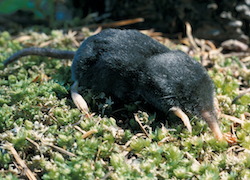
The American shrew mole is the smallest species of mole. It is the only living member of the genus Neurotrichus and the tribe Neurotrichini. It is also known as Gibb's shrew mole and least shrew mole. It is not closely related to the Asian shrew mole. The reason that it is called a "shrew mole" instead of being called either a "shrew" or a "mole" is because of its fur, which is a characteristic of shrews and its large head and heavy dentition, which is characteristic of moles.
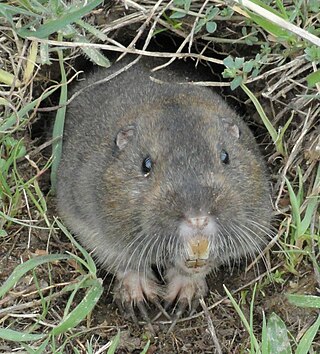
Pocket gophers, commonly referred to simply as gophers, are burrowing rodents of the family Geomyidae. The roughly 41 species are all endemic to North and Central America. They are commonly known for their extensive tunneling activities and their ability to destroy farms and gardens.

The Mazama pocket gopher is a smooth-toothed pocket gopher restricted to the Pacific Northwest. The herbivorous species ranges from coastal Washington, through Oregon, and into north-central California. Four subspecies of the Mazama Pocket Gopher are classified as threatened under the Endangered Species Act of 1973, including T. m. pugetensis, T. m. tumuli , T. m. glacialis, and T. m. yelmensis. The Mazama Pocket Gopher is one of the smallest of 35 species in the pocket gopher family.

Botta's pocket gopher is a pocket gopher native to western North America. It is also known in some areas as valley pocket gopher, particularly in California. Both the specific and common names of this species honor Paul-Émile Botta, a naturalist and archaeologist who collected mammals in California in 1827 and 1828.
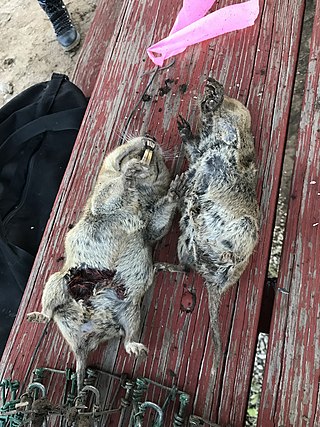
The yellow-faced pocket gopher is a species of pocket gopher that is native to shortgrass prairies in the south-western United States and northern Mexico. It is the species that lives north of the Southern Coahuila Filter-Barrier (SCFB). Among the different species, the yellow-faced pocket gopher has a small to medium-sized skull. The fossil of this genus was recorded from the pre-Pleistocene Benson Beds of Arizona.
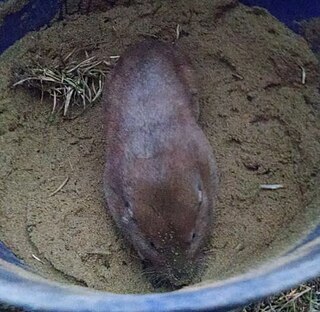
The southeastern pocket gopher is a species of pocket gopher that is native to the southeastern United States. It occurs in Alabama, Georgia, and Florida, where it is the only pocket gopher.

The desert pocket gopher is a species of rodent in the family Geomyidae. It is found in the state of Chihuahua in Mexico and in Texas and New Mexico in the United States.
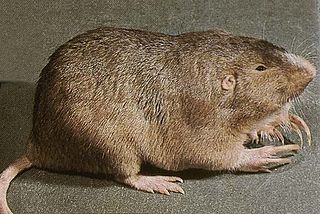
The plains pocket gopher is one of 35 species of pocket gophers, so named in reference to their externally located, fur-lined cheek pouches. They are burrowing animals, found in grasslands and agricultural land across the Great Plains of North America, from Manitoba to Texas. Pocket gophers are the most highly fossorial rodents found in North America.

Heterogeomys is a genus of rodent in the family Geomyidae, found in Mexico, Central America and Colombia. Heterogeomys are a small genus of rodents commonly known as pocket gophers, though the term applies to all genera within the family Geomyidae. The name pocket gopher was earned for this family because of their fur lined cheek pouches that can be used for carrying food. These pouches can also be turned inside out. Species of Heterogeomys are regarded as pests, one of less than 5% of rodent species classified as pests, and the history of man's attempts to control their populations reaches back into Mayan times. Despite some efforts to the contrary, populations of Heterogeomys seem to be on a general upwards trend. Furthermore, all of the species of Heterogeomys are considered to be of Least Concern in the World Status Key.
The variable pocket gopher is a species of rodent in the family Geomyidae. It is endemic to Costa Rica, usually being found in grasslands and tropical forests at higher altitudes, up to 8,000 feet. It is threatened by habitat loss, but are sometimes kept as pets in the United States and elsewhere.
Buller's pocket gopher is a species of gopher that is endemic to Mexico.

The camas pocket gopher, also known as the camas rat or Willamette Valley gopher, is a rodent, the largest member in the genus Thomomys, of the family Geomyidae. First described in 1829, it is endemic to the Willamette Valley of northwestern Oregon in the United States. The herbivorous gopher forages for vegetable and plant matter, which it collects in large, fur-lined, external cheek pouches. Surplus food is hoarded in an extensive system of tunnels. The dull-brown-to-lead-gray coat changes color and texture over the year. The mammal's characteristically large, protuberant incisors are well adapted for use in tunnel construction, particularly in the hard clay soils of the Willamette Valley. The gophers make chattering sounds with their teeth; males and females make purring sounds when they are together, and the young make twittering sounds. Born toothless, blind and hairless, the young grow rapidly before being weaned at about six weeks of age.

The Idaho pocket gopher is a species of rodent in the family Geomyidae. It is rather small, with a lightly built skull. Its fur color varies through the body and between individuals. Found in the western United States, it inhabits savannas, shrubland, and grasslands. Individuals live alone in burrows, staying active year-round. Many aspects of its behavior and biology are not well understood. The species is classified as being of least-concern by the International Union for the Conservation of Nature.

The mountain pocket gopher is a species of rodent in the family Geomyidae. It is endemic to California and Nevada. The Sierra Nevada are part of its range.

Townsend's pocket gopher is a species of pocket gopher endemic to the northwestern United States.

The southern pocket gopher is a species of rodent in the family Geomyidae. It is found in Mexico and the United States, usually in high altitude grassland and shrubland. It feeds on plant material and has an extensive burrow above which is a large heap of earth on the surface of the ground.
The Michoacan pocket gopher is a species of rodent in the family Geomyidae. It is monotypic within the genus Zygogeomys. It is endemic to Mexico where its natural habitat is temperate, high-altitude forests. Its numbers are declining and it is listed by the IUCN as "endangered".

Baird's pocket gopher or the Louisiana pocket gopher is a species of pocket gopher that is native to the southern United States. In total, there are three almost identical species of eastern pocket gopher; Geomys attwateri, G. bursarius, and G. breviceps. G. breviceps is larger in size, G. attwateri is medium-sized and G. bursarius is a bit smaller. Other than by size variation they are not identifiable by external features. Baird's pocket gophers are small rodents with most of their weight on the top half of their bodies.

The Oriental Basin pocket gopher is a species of pocket gopher which is endemic to Mexico. It was first described in 1895 by Clinton Hart Merriam. It was considered to be a subspecies of Merriam's pocket gopher in the late 20th and early 21st century but has been reinstated as its own species. The IUCN Red List has evaluated it to be of least concern.
The Perote pocket gopher, or Cofre de Perote pocket gopher, is a species of pocket gopher in the family Geomyidae.





















